The History Of Chevrolet Corvette

The Chevrolet Corvette is a sports car that has been manufactured by General Motors (GM) since 1953. The car was originally designed by Harley Earl, and named by Myron Scott after the fast ship of the same name. Originally built in Flint, Michigan and St. Louis, Missouri, it is currently built at a General Motors assembly plant in Bowling Green, Kentucky. The National Corvette Museum and annual National Corvette Homecoming, also located in Bowling Green, celebrate the car's history.
There have been six generations of the Corvette produced so far, sometimes referred to as C1 through C6, and various versions with differing features within each generation; the current C6 generation includes the ZR1, which has the most powerful engine used in a production Corvette to date. Over the years, versions of the car have won awards from magazines such as Motor Trend and Car and Driver and from organizations like the Society of Automotive Engineers, and have been used from time to time as pace cars for the long-running Indianapolis 500 race since 1978.
While sold under the Chevrolet marque in the United States and other locations, it is sold under its own Corvette marque in Europe and Japan. The car is built in coupé and convertible versions; the possibility of a sedan version has also been considered by GM executives.
General Motors hired designer Harley Earl in 1927. Earl loved sports cars, and GIs returning after serving overseas in the years following World War II were bringing home MGs, Jaguars, Alfa Romeos, and the like. In 1951, Nash Motors began selling a two-seat sports car, the Nash-Healey, that was made in partnership with the Italian designer Pinin Farina and British auto engineer Donald Healey. Earl convinced GM that they also needed to build a two-seat sports car. Earl and his Special Projects crew began working on the new car later that year, which was code named "Opel." The result was the 1953 Corvette, unveiled to the public at that year's Motorama car show. The original concept for the Corvette emblem incorporated an American flag into the design, but was changed well before production since associating the flag with a product was frowned upon.
Taking its name from the corvette, a small, maneuverable fighting frigate (the credit for the naming goes to Myron Scott), the first Corvettes were virtually hand-built in Flint, Michigan in Chevrolet's Customer Delivery Center, now an academic building at Kettering University. The outer body was made out of then-revolutionary fiberglass, selected in part because of steel quotas left over from the war. Underneath the new body material were standard Chevrolet components, including the "Blue Flame" inline six-cylinder truck engine, two-speed Powerglide automatic transmission, and drum brakes from Chevrolet's regular car line. Though the engine's output was increased somewhat, thanks to a triple-carburetor intake exclusive to the Corvette, performance of the car was decidedly lackluster. Compared to the British and Italian sports cars of the day, the Corvette was underpowered, required a great deal of effort as well as clear roadway to bring to a stop, and even lacked a "proper" manual transmission. Up until that time, the Chevrolet division was GM's entry-level marque, known for excellent but no-nonsense cars.[citation needed] Nowhere was that more evident than in the Corvette.[citation needed] A Paxton supercharger became available in 1954 as a dealer-installed option, greatly improving the Corvette's straight-line performance, but sales continued to decline.
GM was seriously considering shelving the project, leaving the Corvette to be little more than a footnote in automotive history, and would have done so if not for two important events. The first was the introduction in 1955 of Chevrolet's first V8 engine (a 265CID [4.3 L]) since 1919, and the second was the influence of a Soviet émigré in GM's engineering department, Zora Arkus-Duntov. Arkus-Duntov simply took the new V8 and backed it with a three-speed manual transmission. That modification, probably the single most important in the car's history[citation needed], helped turn the Corvette from a two-seat curiosity into a genuine performer. It also earned Arkus-Duntov the rather inaccurate nickname "Father of the Corvette."
Another key factor in the Corvette's survival was Ford's introduction, in 1955, of the two-seat Thunderbird[citation needed], which was billed as a "personal luxury car", not a sports car. Even so, the Ford-Chevrolet rivalry in those days demanded that GM not appear to back down from the challenge. The "T-Bird" was changed to a four-seater in 1958.
Main article: Chevrolet Corvette C1The first generation is most commonly referred to as a "solid-axle", based on the fact that independent rear suspension (IRS) was not available until 1963. The first generation started in 1953 and ended in 1962.
With limited production due to the fact that they were all hand built and assembled, the 1953 Corvette, with a total of only 300 units produced, is the rarest and most sought after Corvette model year. With few changes except for color choices and production numbers, the 1954 is the last Corvette to have a 6 cylinder engine. 1955 saw the introduction of the V-8 engine, replacing the underpowered "Blue Flame" in-line 6. The first seven 55's off the production line did however feature the in-line 6. Aside from the engine, the 1955 model can be differentiated by its logo—the "V" in Corvette is enlarged and gold colored, signifying the V-8 engine under the hood.
In 1956 a new body was designed for the car which changed it from a country club style sports car. One noteworthy addition of optional fuel injection in mid-1957 (also available on Chevrolet Bel Air). Fuel injection first saw regular use on a gasoline engine two years prior on the Mercedes-Benz 300SL "gullwing" roadster. Although the Corvette's GM-Rochester injection used a constant flow system as opposed to the diesel style nozzle metering system of the Mercedes', it nevertheless produced about 290hp (216kW) (gross). The number was listed by Chevrolet's advertising agency for the 283hp/ 283CID (4.6L) "one hp per cubic inch" slogan, making it one of the first mass-produced engines in history to reach 1hp/ CID. Other early options included power windows (1956), hydraulically operated power convertible top (1956), four speed manual transmission (late 1957), and heavy duty brakes and suspension (1957).
The 1958 Corvette saw another body freshening and more options available. This year had the most exterior chrome and was the heaviest of the C-1s. From its quad headlights and hood louvers to its twin trunk spars and bumper exiting exhaust, it was the flashiest Corvette ever built. 1959-60 saw little changes except ever decreasing chrome and increasing HP. For 1961 a complete change to the rear of the car was made, with hints of things to come. It had a "boat tail" rear with the first year to have 4 round tail lights. In 1962, the GM 283 small block was enlarged to 327cuin (5.4L) and produced a maximum of 360hp (268kW) making it the fastest of the C-1s and by now almost completely devoid of chrome.
1962 was the last year for many things: curved windshield, solid rear axle and convertible-only body style. The trunk lid and exposed headlights disappeared for decades, returning in 1998 and 2005, respectively.
Oldest surviving unit
The oldest surviving production Corvette is serial number E53F001003. This historic, one-time GM "test mule" is the third 1953 Corvette to ever come off the Flint assembly line and is known as "double-o-three" to Corvette enthusiasts. It was sold at a Barrett-Jackson auction on January 21, 2006 in Scottsdale, AZ for US$1,000,000.
However, the oldest Corvette in existence is believed to be the EX-122, a pre-production prototype that was hand built and first shown to the public at the 1953 GM Motorama at the Waldorf Astoria in New York City on January 17, 1953. That car can now be seen at the Atlantic City Showroom and Museum of Kerbeck Corvette.
Another noteworthy 1953 Corvette belonged to actor John Wayne. Vin #51 was delivered to Wayne on October 7, 1953. It is currently on display at the National Automobile Museum (formerly the Harrah's Collection) in Reno, Nevada.
Main article: Chevrolet Corvette C2The second generation, or mid-year, was designed by Larry Shinoda with major inspiration from a previous unproduced design called the "Q Corvette" by Peter Brock and Chuck Pohlmann, and under the styling direction of Bill Mitchell, started in 1963 and ended in 1967. Introducing a new name, Corvette Sting Ray, the 1963 model year Corvette was the first year for a coupé with its distinctive split rear window and non-functioning hood vents as well as an independent rear suspension. The split rear window was discontinued in 1964 due to safety concerns. Because they made the design too busy, the hood vents were also cut. Power for 1963 was at 360hp (268kW) hitting 375hp (280kW) in 1964.
Four-wheel disc brakes were introduced in 1965, as was a "big block" engine option (the 396CID [6.5L] V8). Side exhaust pipes became optional on the 1965 Sting Ray and persisted through 1967, then again for 1969. Chevrolet would up the ante in 1966 with the introduction of an even larger 427CID (7L) version, creating what would be one of the most collectible Corvettes ever. 1967 saw an L-88 version of the 427 introduced, which was rated at 430hp (321kW), but unofficial estimates[citation needed] place the actual output at 550hp (410kW) or more. Only twenty such engines were placed in the 1967 Corvette, and the cars can fetch US$1,000,000 or more in auction today. From 1967 to 1969, the 1282cuft/ min Holley triple two-barrel carburetor, or Tri-Power, was available on the 427. The 1967 Corvette originally was going to be the first of the C3 generation; however, due to delays the C3 had to be put off until 1968. This was also the first year to introduce the L-88 motor option with 560bhp (420kW). Other early options available on the C2 included an AM-FM radio (mid 1963), air conditioning (1963), a telescopic steering wheel (1965) and headrests, presumably to prevent whiplash (1966).
The 1965 introduction of the 425hp 396CID big block was ultimately the harbinger of doom for the Rochester fuel injection system. The 396CID option cost $292.70 while the fuel injected 327CID engine cost $538.00. Few people could justify spending $245 more for 50hp (37kW) less. When only 771 fuel-injected cars were built in 1965, Chevrolet stopped the program.
In 2004, Sports Car International named the Sting Ray number five on the list of Top Sports Cars of the 1960s.
The design of this generation had several inspirations. The first was the contemporary Jaguar E-Type, one of which Mitchell owned and enjoyed driving frequently. Bill Mitchell also sponsored a car known as the "Mitchell Sting Ray" in 1959, because Chevrolet no longer participated in factory racing. This vehicle had the largest impact on the styling of this generation, although it had no top and did not give away what the coupe would look like. The third inspiration was a mako shark that Mitchell had caught while deep-sea fishing.
In 1961 the Corvette finally sold over 10,000 vehicles per year, hitting a number of 10,947 in that production year.
In 1962 Corvette chief engineer Zora Arkus-Duntov came up with a lightweight version of the C2. Concerned about Ford and what they were doing with the Shelby Cobra, GM planned 100 Grand Sport Corvettes. The plans never came about and only five were built. They were driven by historic drivers such as Roger Penske, A. J. Foyt, Jim Hall, and Dick Guldstrand among others. Today the cars 001-005 are all held by private owners. They are among the most coveted and valuable Corvettes ever built.
The popular Z06 performance package on the C5 and C6 model Corvettes is named after a Z06 performance option dating back to the 1963 model year.
Main article: Chevrolet Corvette C3The third generation or "Shark", patterned after Chevrolet's "Mako Shark II" (designed by Larry Shinoda), started in 1968 and ended in 1982. This generation has the distinction of being introduced to the motoring public in an unorthodox—and unintended—fashion. 1968 marked the introduction of Mattel's now-famous Hot Wheels line of 1/ 64-scale die cast toy cars. General Motors had tried their best to keep the appearance of the upcoming car a secret, but the release of the Hot Wheels line several weeks before the Corvette's unveiling had a certain version of particular interest to Corvette fans: the "Custom Corvette", a GM-authorized model of the 1968 Corvette. The 1968 corvette was not actually titled "Stingray", although it was almost identical to the "Stingray" 1969 model. Nowhere on the '68 can the word "Stingray" actually be found.
In 1969, the 350cuin (5.7L) engine became available in the Corvette and was the only year that an all aluminum 427 CID big block titled the ZL-1 was available. It was reported to produce a conservative 525horsepower (391kW) and was only available as an "off-road" option without a heater and radio. In 1970 the 427 big block was enlarged to 454cuin (7.4L). Small block power peaked in the 1970 models, with the 1970 LT-1 putting out 370hp (276kW) with the '71 and '72 rated at 330 gross HP. The 1971 454 big block had its last year of big power with the 425hp (317kW) LS6 engine. An even more powerful LS7 454 CID engine rated at 465hp (347kW) was planned and even included in early GM assembly manuals, but was never installed in any production cars. In 1972, GM moved to the SAE Net measurement for power (away from the previous SAE Gross standard), which resulted in lower values expressed inHP. Along with lowered compression ratios from 1971 in anticipation of unleaded fuel, emission controls, and catalytic converters in 1975, power continued to decline and bottomed out in 1975 — the base ZQ3 engine put out 165hp (123kW), and the optional L82 engine put out 205hp (153kW). Power remained fairly steady for the rest of the C3 generation, ending in 1982 with the 200hp (149kW) L83 engine.
Styling changed subtly over the generation. Early model years came standard with an innovative Fiber-Optic light monitoring system. Strands of fiber optic wire went from the center console to the headlights (low and high beam), turn signals, tail lights and license plate light for a total of 9 monitored lights. Due to cost savings, it was discontinued after the 1971 model year. Minor trim changes occurred through the 1972 model. In 1973, due to government regulations, the Corvette had to get rid of the chrome front bumper for a urethane-compound "5mph" bumper but kept the rear chrome bumpers. In 1974, the rear chrome bumpers became urethane as well, resulting in the first ever chrome-less production Corvette. 1975 saw the last year for the convertible, which did not return until 1986. In 1968 the "Sting Ray" name was not used, but returned in 1969 as a single word "Stingray" until 1976. In 1977, Dave McLellan succeeded Zora Duntov as the Corvette's Chief Engineer. 1978 saw a 25th "Silver Anniversary" edition, the first Corvette Indy Pace Car, the introduction of a "fast back" glass rear window, and the highest production number until the C-5. In 1980, the Corvette got an integrated aerodynamic redesign that resulted in a significant reduction in drag. In 1982, an opening rear hatch was offered for the first time on the Corvette available on the Collectors Edition model only. A new engine featuring cross fire injection, a fuel injection carburator hybrid, was also introduced that year as the L83. It was the only engine available in 1982, and was not offered with a manual transmission.
Main article: Chevrolet Corvette C4The fourth generation Corvette began production in March 1983 as a 1984 model. The 1983 model year was skipped due to production problems, although 44 prototype 1983 models were completed. All 44 1983 model year prototypes assembled were crushed except for one (the 23rd produced), which is displayed at the National Corvette Museum in Bowling Green, Kentucky. Corvette C4 production began in March 1983 as a 1984 model, and ended in 1996.
This first year model of the C4 carried over the L83 engine from the previous, 3rd generation Corvette. The L83 engine had a unique fuel delivery method dubbed "Crossfire": a dual throttle-body injection system. With the first major body, chassis and suspension change since 1963, the new C4 coupe incorporated a rear glass hatch for much improved cargo access, all new brakes with aluminum calipers, an all aluminum frame and suspension for weight savings and rigidity, and the first one piece targa top with no center reinforcement. The Corvette C4 came standard with an electronic dashboard with digital liquid crystal displays for the speedometer and tachometer. The 1984 C4 was a complete and total redesign except for its engine, and the emphasis was on handling with the introduction of the front transverse composite leaf spring (still used today on new Corvettes). This handling focus came with the penalty of a harsh, uncompromising ride in the 1984 model.
Between 1984 and 1988, the Corvette utilized an unusual "4+3" transmission—a 4-speed manual coupled to an automatic overdrive on the top three gears. It was designed to help the Corvette meet U.S. fuel economy standards. The transmission was problematic and was eventually replaced by a much more modern and satisfactory ZF 6-speed manual gearbox in 1989. This new transmission was also the first to feature Computer Aided Gear Selection (CAGS), which used a solenoid to lock out 2nd gear during certain driving conditions. This allowed the Corvette to maintain EPA fuel economy ratings high enough to avoid the "gas guzzler" tax. Beginning in 1985, the 230horsepower (170kW) L98 engine with tuned port fuel injection was the standard engine.
In 1986 the 2nd Indy Pace Car version was released as a convertible only. It was the first drop top Corvette since 1975. It was also the first pace car fast enough in stock form to pace the Indianapolis 500.[citation needed] A Center High Mounted Signal Light (CHMSL, a third center brake light) was added in 1986 to comply with federal law.
1988 saw the 35th Anniversary Edition. Each of these featured a special badge with an identification number mounted next to the gear selector. These Corvettes were easily identified with their white exteriors, wheels and interiors.
For the 1992 model year, the 300horsepower (220kW) LT1 engine was introduced, which improved output to 300hp (220kW), compared to the L98 in ideal tune with 250hp (190kW). Also introduced in 1992 was Acceleration Slip Regulation (ASR), a form of traction control which utilized the Corvette's brakes, spark retard and throttle close-down to prevent excessive rear wheel spin and possible loss of control. The traction control device could be switched off if desired.
1993 marked the Corvette's 40th anniversary. Special versions had a commemorative Ruby Red color, 40th anniversary badges and embroidered seat backs. The 1993 Corvette also marked the introduction of the Passive Keyless Entry System, the first GM car to feature it.
1996 was the final year of C4 production, and featured special models and options, including the Grand Sport and Collector Edition, OBD II (On-Board Diagnostics), run flat tires, and the LT4 engine. The 335hp (250kW) LT4 V8 was installed in all manual transmission equipped Corvettes. All 1996 Corvettes with automatic transmissions utilized the LT1.
The C4's handling characteristics and cornering ability allowed it to dominate SCCA events and races during the 1980s and 1990s. It was undefeated in SCCA Showroom Stock competition from 1985 through 1987, despite Porsche's best efforts. Porsche reportedly even obtained a C4 Corvette for teardown and examination.[citation needed]
The C4 had plenty of firsts: EFI (Electronic Fuel Injection), composite transverse leaf springs, antilock brakes, airbags, traction control, an aluminum frame and suspension components, digital gauges, overhead cams and four valves per cylinder in the superb ZR1, a computer controlled, six-speed manual transmission, climate control, and a digital instrument panel. Conversely, C4 Corvettes were the last generation to utilize a centrally located fuel filler (1963), opposing windshield wipers (1953), a cast iron engine block (1953), 4 round taillights (1961), fiberglass body panels (1953), distributor ignition (1953).
B2K Callaway Twin-Turbo
In 1987, the factory B2K option became available from the factory.
The Callaway Corvette was a Regular Production Option (RPO B2K), the only time in Chevrolet's history a specialist manufacturer was entrusted with a technically advanced high performance RPO. The B2K option was eventually replaced by the ZR1 option, though they coexisted from 1990-1991. The early B2K's produced 345hp (257kW) and 450ft·lbf (610N·m) of torque. The later B2K's produced 450hp (336kW) and 613ft·lbf (831N·m) of torque.
ZR-1 (1990–1995)
In 1986, the Corvette team approached Lotus, then a GM subsidiary, with the idea of developing an ultra-high performance vehicle based on the C4 Corvette. With input from GM's "Corvette Team" of engineers and designers, Lotus designed a new engine to replace the traditional pushrod L98 V-8 that powered the standard C4. The result was the LT5, an aluminum-block V-8 with the same bore centers as the L98, but with four overhead camshafts and 32 valves. Lotus designed a unique air management system for the engine to provide a wider power band by shutting off 8 of the 16 intake runners and fuel injectors when the engine was at part-throttle, while still giving the ZR-1 375hp when at wide open throttle. As Chevrolet had no facility available which could manufacture the new LT5, construction of the engines was subcontracted to Mercury Marine, a company in Stillwater, Oklahoma which normally specialized in high-performance marine engines.
Lotus also aided in the development of the ZR-1's standard "FX3" active suspension system, which would provide the basis for active suspension systems found (as optional equipment) on all Corvettes since. Much of the ZR-1 tuning was done at Belding, Michigan's "Grattan" raceway.
In 1990, the ZR-1 set a 24 hour speed endurance record at the Firestone test track in Fort Stockton Texas using a near-stock LT5 engine with only minor modifications, including removal of the catalytic converters. The Tommy Morrison racing team averaged 175mph (282km/ h), including time for re-fueling and several driver changes.
In 1991, all Corvettes received updates to body work, interior, and wheels. The convex rear fascia that set the 1990 ZR-1 apart from the base model was now included on L98 Corvettes, making the styling of the expensive ZR-1 even closer to that of the base cars. The most obvious difference remaining between the base and ZR-1 models besides the wider rear wheels was the location of the CHMSL (center high mounted stop lamp), which was integrated into the new rear fascia used on the base model, but remained at the top of the rear-hatch on the ZR-1's. All corvette ZR-1's had a interesting feature, a power key. It was mounted underneath the radio and using a key you could turn the power from "full" which means all the horsepower and "normal" which disabled the secondary intake ports cutting the power to 200hp (150kW). This system is commonly referred to as a "valet key", and was reset to "normal" after the engine was shut off.
Further changes were made in 1992: ZR-1 badges were displayed on both front fenders and traction control was added as a standard feature. In 1993, Lotus redesigned the cylinder heads and valve-train of the LT5, resulting in a horsepower increase from 375 to 405. In addition, a new exhaust gas recirculation system improved emissions control. Production of the ZR-1 ended in 1995, after 6,939 cars had been built.
Grand Sport (1996)
Chevrolet released the Grand Sport version in 1996 at the end of C4 Corvette production. The "Grand Sport" moniker was a nod to the original Grand Sport model produced in 1963. A total of 1,000 Grand Sports were produced. The 810 coupes and 190 convertibles were produced with a special VIN sequence to differentiate them from the other 1996 C4 models. The 1996 Grand Sport was equipped with the LT4 engine, which produced 330hp (246kW) and 340lb·ft (461N·m) of torque. All LT4-powered Corvettes included a Grand Sport nameplate on the engine's throttle body. The Grand Sport came only in Admiral Blue with a white center stripe, distinctive black five spoke wheels, and two red hash marks on the hood above the left front wheel. Interior colors were black and red only. A hardtop option was not available with Grand Sport convertibles. They also added rear wheel arch extensions on the body, as the Grand Sport utilized the same rear wheels as a ZR-1.
Collector Edition (1996)
To commemorate the final year of the C4, Chevrolet reissued a Collector Edition. Also produced in low numbers, all CE's were painted Sebring Silver, a color reminiscent of the 1963 Sting Ray and later retained for the C-5 color lineup. A near mirror image of the Grand Sport, if properly equipped, it also got the 5 spoke "A mold" wheels in matching silver, bigger ZR-1 brakes, and a myriad of standard features. Like all production 1996 Corvettes, the LT-4 received the ZF 6-speed gearbox thought by many to be the strongest GM transmission ever.[citation needed] Automatics were an option, and still retained the LT-1. CE's were also available in a convertible with 3 interior color choices, red, silver and black. On all four sides of the car, a special set of "Collector Edition" flags were appointed, and also embroidered in the seat backs.
Main article: Chevrolet Corvette C5Production of the C5 Corvette began in 1997 and ended with the 2004 model year. The C5 was a major change from the long-running C4. The transmission was moved to the rear of the car to form an integrated rear-mounted transaxle assembly and was connected to the engine by a driveshaft. Gone were most of the squeaks and rattles of the C4. The new C5 was judged by the automotive press as improved in nearly every area over the previous Corvette design.
Also introduced with the C5 was GM's new LS1 small block. This third-generation small block was a completely new design, including a distributor-less ignition and a new cylinder firing order. It was initially rated at 345horsepower (257kW) and 350ft·lbf (470N·m) torque, but was increased to 350horsepower (260kW) in 2001.
For its first year, the C5 was available only as a coupe, even though the new platform was designed from the ground up to be a convertible. The convertible returned to the lineup in 1998, followed by the predecessor to the Z06, the fixed-roof coupe (FRC), in 1999.
The Corvette's 50th Anniversary was celebrated June 20-21, 2003, in Nashville, Tennessee. The venue provided a bonanza of flawlessly restored Corvettes. Also, a worldwide caravan of over 10,000 Corvettes gathered at the National Corvette Museum in Bowling Green, KY. with every model year of the Corvette along with engineering and restoration seminars. Participants were also invited to visit the factory located across from the museum, with special tours not provided to the general public. The anniversary also brought some Chevrolet Concept Vehicles into focus including the approved-for-production Chevrolet SSR. Also on hand were several Corvette race cars, including the Corvette SS built by Zora Arkus-Duntov and the C5-R that won its class at Le Mans. Among the many displays were examples of the 2003 50th Anniversary Edition as well as a few 2004 "Commemorative Edition" and Indy Pace Car Corvettes.
Recently, the factory has expanded to build the Cadillac XLR roadster, which shares its platform with the sixth-generation Corvette. Bowling Green is also home to the Corvette Museum, which celebrates this American automotive icon by displaying in chronological order the various regular production models as well as some unique one-off versions created by Chevrolet. Bowling Green is also the home of the National Corvette Homecoming, a large annual gathering of Corvettes and their owners.
The building in Flint in which the first cars were assembled was spun off with GM's Delphi Electronics division and later donated to GMI/ Kettering University in the late 1990s. The building has since been remodeled and is now the C.S. Mott Engineering and Science Center, housing the Mechanical Engineering and Chemistry programs. In the garage housing the school's Society of Automotive Engineers (SAE) club is a plaque commemorating it as the place where the first Corvette was built.
Z06 (2001–2004)
Main article: Chevrolet Corvette C5 Z06A successor to the FRC C5 made its debut in 2001 as the Z06, a nod to the high performance Z06 version of the C2 Corvette of the 1960s. The Z06 models replace the FRC hardtop (1999–2000) models as the highest performance C5 Corvette. Instead of a heavier double-overhead cam engine like the ZR-1, the Z06 used an LS6, a high-output version of the standard LS1 Corvette engine producing 385hp (287kW). Although the Z06's total power output was less than that of the last ZR-1's, the Z06 was lighter and therefore quicker than the ZR-1. Despite these specifications, the ZR-1 still had a higher top speed, thus maintaining its "King of the Hill" status.
As with the ZR-1, Chevrolet found that added power output did the Z06 little good without platform modifications to bring the rest of the car up to par. A hardtop body, upgraded suspension, larger wheels and tires, a new six-speed manual transmission, along with improved gearing and functional brake cooling ducts, all became part of the total package. The Z06 is 38lb (17.3kg) lighter than the previous hardtop C5 thanks to a titanium exhaust (from the catalytic converter back), thinner glass, lighter wheels, and a lighter battery. From 2002 onward, the Z06 produced 405hp (302kW) thanks to minor engine modifications including a more aggressive camshaft profile, lightweight sodium filled exhaust valves, stiffer valve springs, and deletion of the precats. Many dynamometer tests have proven that Chevrolet underrated the engine by 20hp (15kW) giving it a total of 425hp.
The 2002 Z06 also received revised rear shock valving and steel links to replace plastic ones of the 2001 model. An Electron blue color replaced Speedway white. The HUD became standard, and the previous forged wheels were replaced by lighter spun cast ones. The fender Z06 badges bear "405hp" on them. The 2003 models received special silver 50th anniversary badges and revised headliner. Later 2003 models received a more durable steel shift fork instead of aluminum.
GM claimed that 405hp (302kW) versions of the Z06 could make the 0-60 run in 3.9 seconds and through the quarter mile in 12.4 seconds. In the hands of experienced drivers the 2002–2004 Z06 has made 11 second passes. The current quarter mile record is 11.7. The car's top speed of 176mph (283km/ h) was achieved in 5th gear at 6,500rpm(redline), as 6th gear was an overdrive/ economy gear. It proved to be a well rounded track vehicle as well, with the ability to do more than simply accelerate. Thanks in part to its upgraded suspension system, the Z06 is capable of holding its own against contemporary versions of the Dodge Viper and even the Porsche 911 Turbo around a road track.
The 2004 Z06 Commemorative Edition came with a carbon fiber hood which saved some weight and also received polished aluminum wheels. In addition it was equipped with a Nürburgring-tested suspension tuning to improve handling, along with an exclusive Le Mans blue color.
C5-R
The C5-R racer was built by Pratt & Miller for GM Racing. It was based on the C5 road car but had a longer wheelbase, a wider track, an enlarged engine and more aerodynamic bodywork with a rear wing and exposed headlamps. It took part in the American Le Mans Series in the GTS Class and competed in five 24 Hours of Le Mans races as a Corvette Racing entry.
- 1999 The car's debut racing season. Initially it was powered by a 6000cc version of the 5700cc Corvette V-8 engine but after four races the engine capacity was increased to 7000cc.
- 2000 The car's first victory and first year at Le Mans.
- 2001 The racing season produced eight victories in ten races, including an overall win in the 24 Hours of Daytona and a 1-2 finish in the GTS class at Le Mans.
- 2002 In 2002 the C5-R repeated its 1-2 victory in the GTS class at Le Mans and also dominated the GTS class in the American Le Mans Series. A new transaxle unit replaced the previous year's separate transmission and differential. Corvette faced stiff domination from the new Privateer Non-Ferrari backed Prodrive-built Ferrari 550, which led many laps at Le Mans, but the Ferraris suffered problems late in the race, resulting in another Corvette GTS class victory.
- 2003 In 2003, the Automobile Club de l'Ouest placed additional restrictions on all 24 Hours of Le Mans competitors, reducing power by 10% in an attempt to slow the cars. At the 2003 season-opening 12 Hours of Sebring, the C5-Rs remained in winning form, with one of them finishing first in class and eighth overall. Also in 2003 a special red, white, and blue color scheme was introduced to celebrate the Corvette's 50th anniversary. At Le Mans the Prodrive Ferraris took first place and spoiled the anniversary and GM's effort for a three-peat in the GTS class.
- 2004 The C5-R was again victorious in the GTS class at the 24 Hours of Le Mans. One of the Privateer Prodrive Built Ferraris led most of the race. About halfway into the event, both Prodrive cars suffered mechanical problems, causing them to pit and lose laps. The Corvettes went on to finish 1-2 in their class.
In 2005, the factory Corvette Team began racing the C6.R to coincide with the new sixth generation (C6) Corvette being released to the public. Private teams, primarily in Europe, continued to race the C5-R.
- 2005 In the FIA GT Championship, the GLPK-Carsport team won races at Imola, Italy and Zhuhai, China, and finished on the podium on several occasions. In the ALMS, Pacific Coast Motorsports scored several podium finishes behind the new factory C6-R cars. SRT fielded a C5-R in the Belcar series in Belgium, and PSI Experience did the same in the FFSA GT Championship in France.
- 2006 The C5-R returned to Le Mans for the first time as a non-factory entry, run by Le Mans regular Luc Alphand. It finished 3rd in the GT1 class behind the C6.R and Prodrive Aston Martin. C5-Rs were run in Belcar and FFSA GT once more.
- 2007 GLPK-Carsport and SRT run C5-Rs in FIA GT, while Luc Alphand runs a Corvette for the Le Mans Series and 24 Hours of Le Mans.
The new C6 gets an overhaul of the suspension geometry, all new bodywork with exposed headlamps (for the first time since 1962), a larger passenger compartment, and a larger 6.0L (≈366cuin) engine. Overall, shorter and narrower than the C5, to gain wider appeal to the European market. The 6.0L LS2 V8 produces 400hp (298kW) at 6000rpm and 400ft·lb (542N·m) of torque at 4400rpm. Its redline is increased to 6500rpm.
The C6 retains the relatively good fuel economy of the C5, due in part to its relatively low drag coefficient and low weight, achieving 18/ 27 mpg (city/ highway) when equipped with an automatic transmission. The manual version is slightly better at 18/ 28; like all manual transmission Corvettes since 1989, it is fitted with Computer Aided Gear Selection (CAGS) to improve fuel economy by requiring drivers to shift from 1st gear directly to 4th at lower RPMs.
For 2008, the Corvette received a mild freshening: a new LS3 engine with displacement increased to 6.2L (≈378cuin), resulting in 430hp (321kW) and 424lb·ft (575N·m) of torque (436 HP and 428 TQ if ordered with the optional performance exhaust). The 6-speed manual transmission also has improved shift linkage and a 0-60 time of 4.0 seconds, while the automatic is set up for quicker shifts giving the C6 Automatic a 0-60 time of 4.3 seconds, faster than any other production automatic Corvette. The interior was slightly updated and a new 4LT leather-wrap interior package was added. The wheels were also updated to a new five-spoke design.
Z06 (2006–)
The new Z06 arrived as a 2006 model in the third quarter of 2005. It has a 7.0L (7,008cc/ 427.6CID) version of the small block engine codenamed LS7. Officially certified output is 505hp (377kW). Its performance is comparable to the Dodge Viper SRT-10. Official performance figures indicate that the Z06 can reach 60mph (97km/ h) in just 3.7 seconds from a standing start in first gear, hitting 0–100 in about 7.3–8.2, with a quarter mile time of 11.7 and a top speed of 198 mph (electronically limited). In the summer of 2005, GM and Corvette Racing driver Jan Magnussen brought the new Z06 to the Nürburgring in Germany. Magnussen drove the Z06 to a time of 7:42. In their March 2007 comparison, Car and Driver selected the Corvette Z06 as the winner of their three-way comparison test of performance cars, with the Porsche 911 GT3 finishing second and the Lotus Exige S third.
In addition to the larger engine, the C6 Z06 has a dry sump oiling system, ensuring proper engine lubrication during periods of high (lateral) acceleration and allowing the engine to be mounted low inside the chassis. Connecting rods made out of titanium further lighten the reciprocating mass of the engine while being stronger than the steel rods they replace.
In a radical departure from anything Chevrolet has ever done before, the primary structural element of the C6 Z06 is aluminum instead of steel as on the non-Z06 cars. The hydroformed aluminum frame remains dimensionally identical to its steel brethren but is significantly lighter. The front fenders are made of carbon fiber to reduce weight, while wider rear fenders allow for the wider tires necessary to deal with the engine's increased power. For an additional mass savings of 6kg, the Z06 replaced the base model's aluminum engine cradle with one made from high pressure die cast magnesium. The Z06 officially weighs 3130lb (1421kg), giving it a power to weight ratio of 6.2lb/ hp (3.8kg/ kW or 361bhp (269kW) per tonne). The C6 Corvette Z06 is the first 500+hp production car to avoid the U.S. government Gas Guzzler tax.
The Z06 was the official pace car for both the 2006 Daytona 500 and the Indianapolis 500 race. The special Pace Car edition Z06 was unveiled at the Los Angeles Auto Show in January. It was also awarded to St. Louis Cardinals shortstop David Eckstein as his prize for being the 2006 World Series MVP, although Eckstein does not know how to drive a stick. The car was reportedly given to his father. The 2007 Z06 was also one of Automobile Magazine's "Automobile All-Stars" for 2007.
The 2007 Z06 had minor changes including retuning of the suspension after some magazine test drivers announced the suspension did not perform up to their original estimates. Chevrolet announced the models were pre-released, and for 2007 they would retune the damping. In more recent tests the Corvette has shown improved driveability and track manners.
In 2008 the Z06 received the new TR6060 six speed manual transmission, which replaces the T-56. The steering rack and the interior plastic bezel were improved. An optional full leather interior (option 3LZ) also became available in limited quantities due to constraints.
ZR1 (2009–)
Main article: Chevrolet Corvette C6 ZR1The Corvette variant now officially known as the ZR1 was first reported by several print and online publications who were speculating that Chevrolet was developing a super high performance production version of the Corvette and were internally calling it "Blue Devil" (named after GM CEO Rick Wagoner's alma mater, Duke University). Wagoner is quoted as saying, "I wonder what they can do for 100,000 dollars?" during a GM board meeting speaking about Chevrolet designers. The production version debuted at the 2008 North American International Auto Show and will be available as a 2009 model.
The ZR1 was formally announced in a December 2007 press statement by General Motors, where it was revealed that their target of 100 horsepower/ liter (1.64hp/ cuin) has been reached by a new "LS9" engine, an Eaton-supercharged 6.2-liter engine producing a confirmed 638hp (476kW) and 604foot-pounds force (819N·m) of torque with a sticker price of about US $100,000. The engine is the most powerful engine to be put in an American production sports car. Top speed is 205mph (330km/ h). Along with an improved motor, the ZR1 also comes with extensive carbon-fiber body parts, including (but not limited to) wider fenders, the hood, roof panel, roof bow, front fascia splitter and rocker moldings. However, the car is heavier and more front weight biased than the Z06 because of the supercharger, with a weight distribution of 52% at the front and 48% at the rear. Tires were also increased in diameter and width, along with bigger and stronger brakes, adjustable suspension, and optional chrome wheels and a premium interior package.
Spy photos from recent hot laps at Mazda Raceway Laguna Seca, following the 2007 American Le Mans Series final race, show the ZR1 to have carbon-ceramic brakes, extensive carbon fiber (front quarterpanels, A- and B- pillars, as well as the roof and possibly other body panels), and a full-width rear lip spoiler.
C6.R
- 2005 The C6.R was unveiled for its first race at the 2005 12 Hours of Sebring endurance race of the American Le Mans Series. Later, in the 2005 24 Hours of Le Mans, it made up for Sebring by placing first and second in the GT1 car class (5th and 6th overall) after a lengthy duel with the Aston Martin team's DBR9 racers. Corvette C6.R went on to win its class at every race it entered in the 2005 ALMS season.
- 2006 In 2006 Corvette C6.R won both American Le Mans GT1 Championships: Teams and Manufacturers.
- 2007 On March 17, 2007 the C6.R won the GT1 class in the 12 Hours of Sebring. For Le Mans 2007, there were four C6.R's on the entry list, as the two Corvette Racing entries were joined by single entries from the Luc Alphand Adventures and PSI-Motorsport teams. However, the Corvettes could not equate their increased numbers into a GT1 class win, as Corvette Racing finished second in class, one lap behind the class-winning DBR9 entered by Aston Martin Racing.
Mike Connor of Motor Trend said that the next generation of Corvettes will not debut until 2012. Connor indicated that GM executive Bob Lutz favored a mid-engine design for the C7 to more easily implement cylinder deactivation, but the company stopped considering it due to high redesign costs.
In May 2007, Bob Lutz stated he is not at all opposed to the idea of a Corvette sedan. This would follow in the footsteps of the Porsche Panamera and Aston Martin Rapide. In subsequent statements however, Lutz said that this statement was made merely as an option, as an example of the way that Chevrolet considers all possibilities during the design process.[citation needed]
The Corvette was Motor Trend magazine's Car of the Year for 1984 and 1998. It has also been on Car and Driver magazine's annual Ten Best list fifteen times: the C4 from 1985 through 1989, the C5 in 1998, 1999, and 2002 through 2004, and the C6 from 2005 through 2009. The C6 was also nominated for the North American Car of the Year award for 2005. The C6 Z06 was named "Most Coveted Vehicle" in the 2006 Canadian Car of the Year contest.
Automobile Magazine ranked the 1963–1967 Sting Ray first on their "100 Coolest Cars" list, above the Dodge Viper GTS, the Porsche 911, and others. Sports Car International placed it at number 5 on their list of the Top Sports Cars of the 1960s.
The 1999 Corvette Convertible, along with the Mercedes-Benz S500, were named "Best Engineered Car of the 20th century" by the Society of Automotive Engineers publication Automotive Engineering International.
A Corvette has been selected as the pace car at the Indianapolis 500 ten times: 1978, 1986, 1995, 1998, 2002, 2004, 2005, 2006, 2007, and 2008.
With the move toward rebadging Daewoo cars as budget-priced Chevrolets in Europe, Corvette became a marque in its own right in 2005. The brand is sold separately from Korean-built Chevrolets, usually by dealers with the premium Cadillac range. Corvette is also marketed as a separate marque in Japan. The rumor that Corvette would become its own brand has been circulating[citation needed] since the late 1980s.
From Wikipedia, the free encyclopedia
More About Chevrolet Corvette
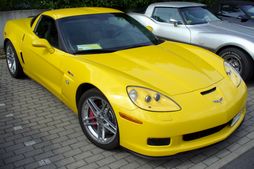
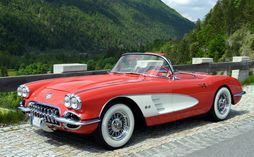
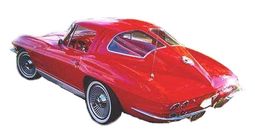
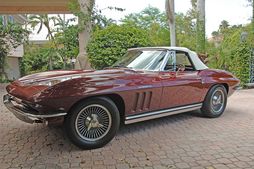
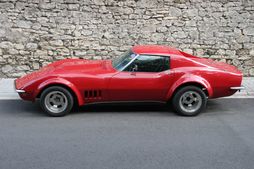
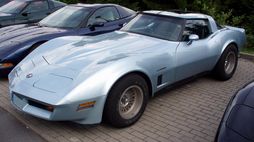
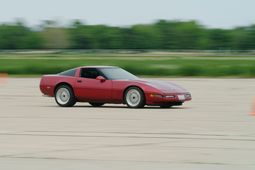
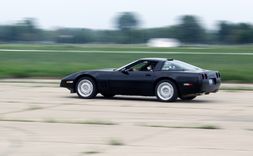
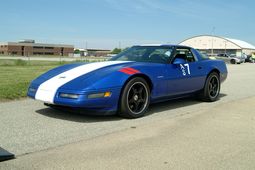
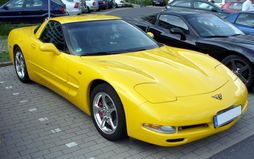
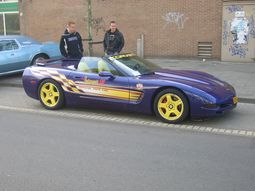
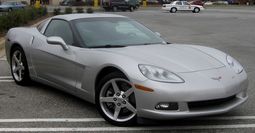
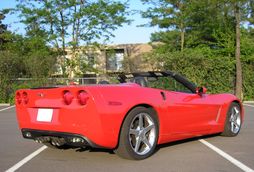
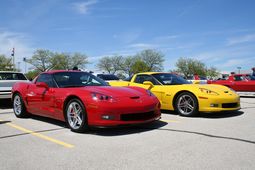
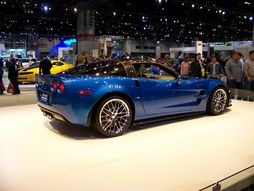
|